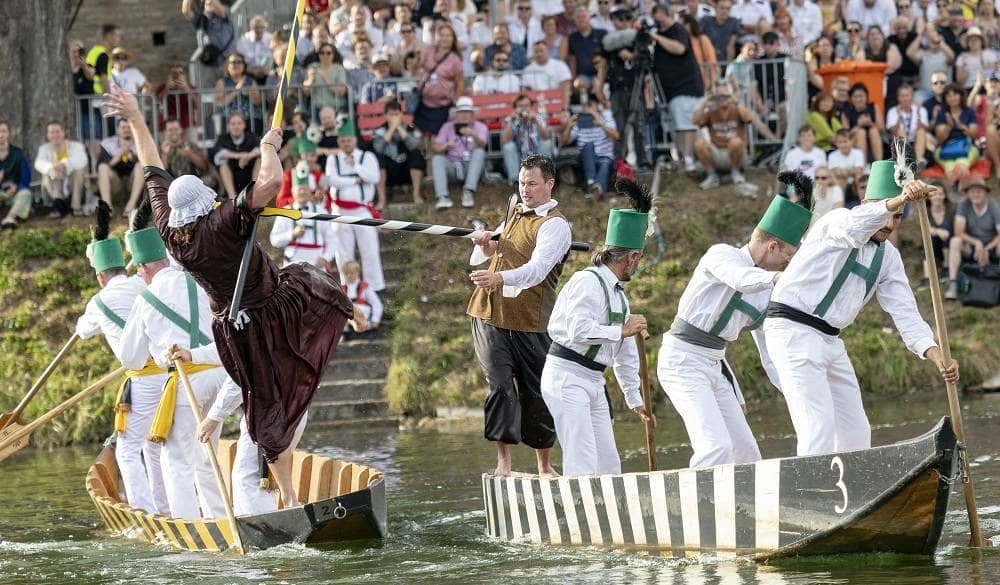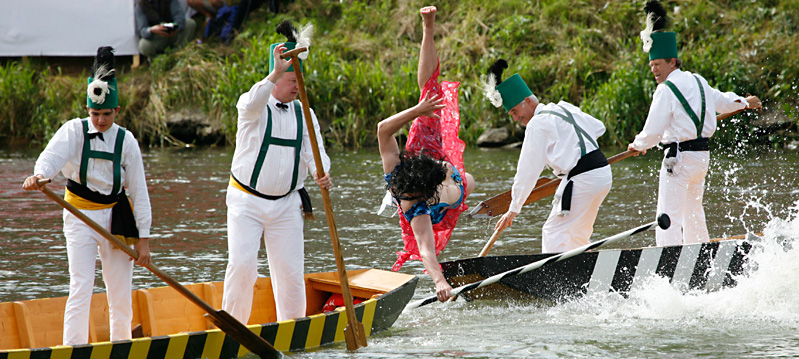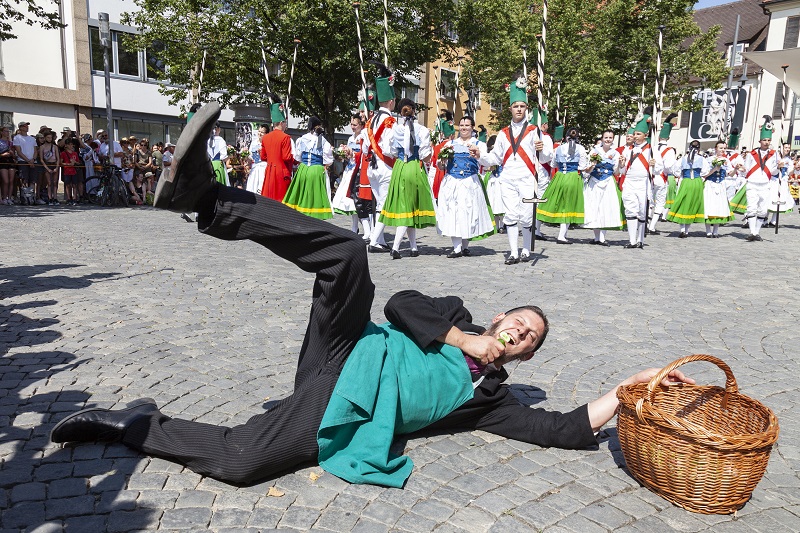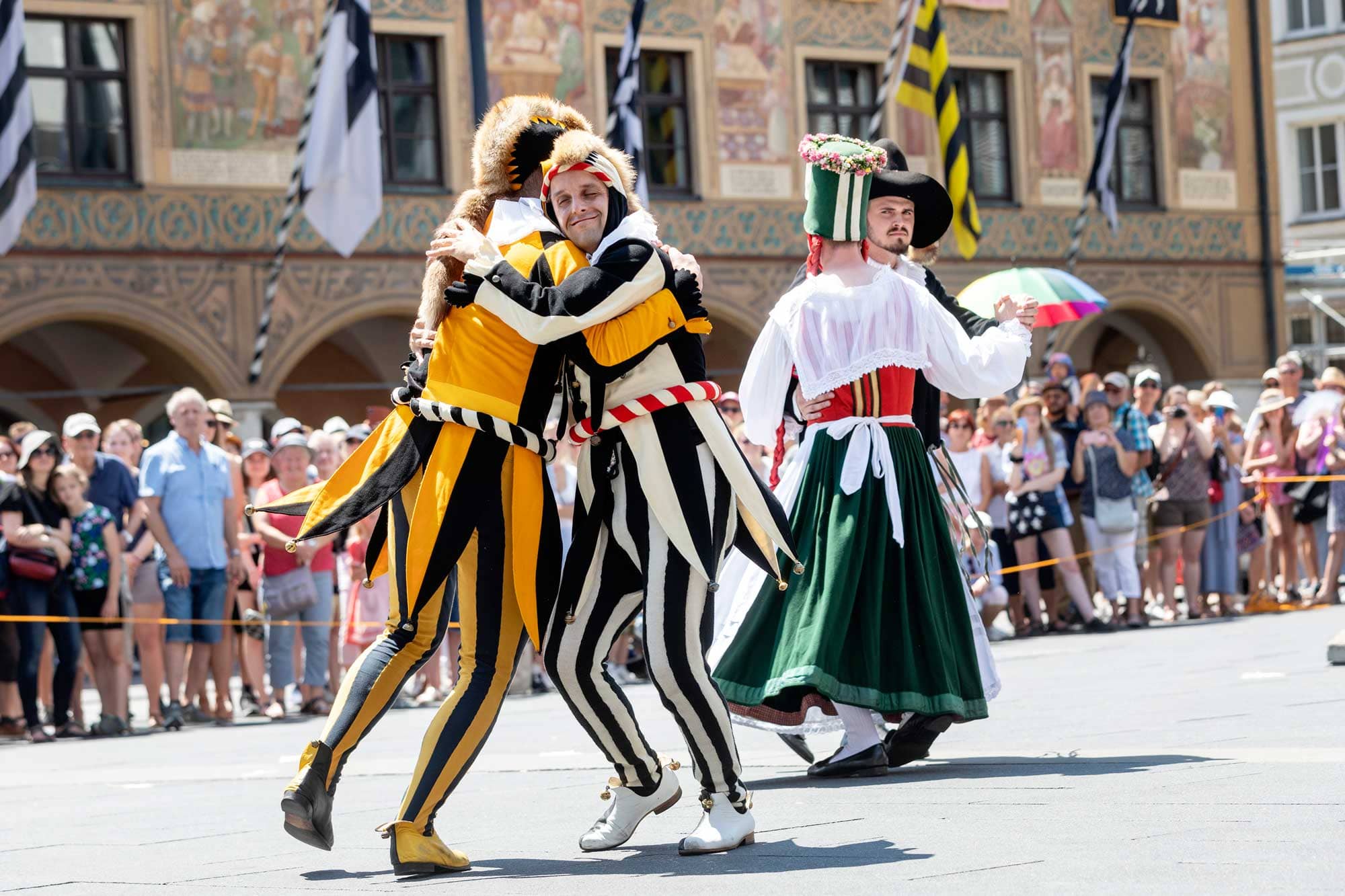Ulm Fishermen's Jousting Tournament

© City of Ulm
Spears crash into ribs. Whoever falls into the water has lost. Whoever steps into the boat is also deemed to be “wet”. The jouster remaining standing on the stern is regarded as “dry” and progresses to the next round. If both remain dry, the contest is a draw. It is repeated until there is a winner.

© Stadt Ulm
The programme
identifies the jouster-pairs as “white fishermen”, “jesters”, “farmer and
farmer’s wife”, “Ulm sparrow” and “tailor of Ulm” etc. These figures reflect
the history of the Fishermen’s Jousting Tournament, the spirit of the various
ages and not least the history of Ulm and the legends surrounding it.
The “white fishermen” are named after
the white costumes they wear for the tournament. There is a variation known as
the „white fisherman in festive garb“, who wears a red jacket. The white
fisherman’s costume possibly goes back to the origins of the fishermen’s
jousting tournament, namely the carnival of the early modern age. At that time
the various tradesmen’s guilds preferred white costumes when performing the
traditional carnival customs. In those days – not only in Ulm and not only in
the fishermen’s trade– journeymen tradesmen used to imitate the jousting
tournaments of knights on horseback in their own way.
Thus, according to a quirky local
legend, two Ulm fishermen named Käßbohrer and Molfenter observed a knights’
jousting tournament held by monks from Reichenau Monastery who were resident in
Ulm. The two observers decided that they could do that too, whereby due to a
lack of horses required for the tournament, they used their boats on the river.
It might really have come about like
that, since the first records of the Ulm Fishermen’s Jousting Tournament originate
from the 16th century: On February 20, 1545 the council refused
permission to hold a Fishermen’s Jousting Tournament. The corresponding entry
in the council records is the oldest indication of the practice of this custom
in Ulm.
The farmer and the farmer’s wife, as
well as the pair of jesters, are also figures that featured in the early modern
town carnival. For the townspeople, the farmers were the personification of
doltishness. The figures of the white fishermen, the jesters, the farmer and
the farmer’s wife probably date back to the beginnings of the tournament.
When the people of Ulm stopped
celebrating carnival– that was shortly before the 30-Years War– the council
urged the fishermen to hold their tournament in a warmer season. Thus the date
was moved to the Monday following Ulm’s parish fair in the last week of July. However,
in the 17th century, the date was moved again to “Oath Tuesday”. That was the
day following the annual Oath Day, the highest political festival in the town: On
the Monday after the annual council elections at the beginning of August, the
male population swore their oath to the Imperial Town Constitution. This was
followed by boisterous celebrations, whereby the Fishermen’s Jousting Tournament,
held every two years, enhanced the festive character of the event.
When Ulm lost its status as an
imperial town in 1802 and became Bavarian, the basis for the Oath Day was lost and
with it the event to which the Fishermen’s Jousting Tournament was linked. It remained
to be rediscovered by the nationalistic movement of the early 19th century,
with its nostalgia for the middle ages.
In the 19th century, the fishermen
occasionally held jousting tournaments to commemorate the loss of Oath Day.
Further occasions were royal visits and other conferences and meetings. Right
from the beginning, the people of Ulm had recognized the folkloristic
attraction that the event had for high-ranking visitors to the town. The second
record of a Fishermen’s Jousting Tournament was therefore in conjunction with a
visit from Prince Philipp of Spain in the year 1549: The fishermen jousted in
his honour, before appearing for their regular carnival tournament some days
later. Jousting tournaments were also a necessary feature of all the great town
festivals and could not be dispensed with, especially not in the historic
processions spawned in the 19th century. Such a procession was held in 1877 on
the 500th anniversary of the laying of the foundation stone for Ulm Minster.
These historic processions featured
new figures to enhance the repertoire of characters for the Fishermen’s Jousting
Tournaments, in which figures from local legends, such as the Ulm Sparrow, for
example or the Tailor of Ulm, have also featured since 1877. The completion of
the building of Ulm Minster in 1890 offered another occasion for a Fishermen’s Jousting
Tournament, now enhanced by the figures of “cowherd and councillor”: Because
the municipal cowherd was found drunk on duty, the councillor wanted to sack
him. The cowherd listened in to the conversation through a vent on the stove and
pre-empted the sacking, handing in his notice by shouting it through the
heating pipe.
In the 20th century,
the Fishermen’s Jousting Tournament was first discovered by the tourist trade, and
in the 1930’s it was exploited by the National Socialists to propagate their
blood and soil ideology. For instance, they paired Swabianism with anti-Semitism
in the characters of “Swabian Smallholder from the Alb” against “Jewish
Mortgage Lender”.

© City of Ulm
After WWII, the continuously varying cast
of characters was enriched by other permanent pairs. In 1950 the successful duo
“Krätte-Weber (basket weaver) and Bollezei (policeman)” were added. Jakob Weber,
who died in 1920, was a vegetable and antiques dealer infamous for his rudeness
and who used to carry his wares around in a basket (= Krätten). He was
particularly fond of insulting the law enforcement officers.
The historic figures of Karl V and
Moritz of Saxony were also introduced in 1950. They were on opposing sides in
the Margraves War of 1552, when Ulm supported Karl V. In 1954 the jousting
troupe was increased by another couple of war lords whose activities had also
affected the fortunes of Ulm: Wallenstein and initially Bernhard of Weimar. But
the latter was replaced in 1970 by the better known Gustav Adolf.
Since 1958, “Türkenlouis” (Margrave
Ludwig Wilhelm I. von Baden) and Grand Visier (Mustafa Koprülü) have stood as a
reminder of the Turkish wars of the late 17th century. With the aid of Ulm
boatmen, military supplies were transported from Ulm along the Danube to the
battle fields.
An original Ulm woman among the
jousting figures is Sabina Heilbronnerin, landlady of the Swan Inn. She stood
up against hostile Bavarian officers when these drank the health of their prince
elector Max Emanuel in occupied Ulm – to be precise, in her inn. The landlady
countered with “Vivat Leopoldus” – that was her emperor -, and since 1970 she
has jousted against Max Emanuel. Since then, not much has changed in the cast
of characters, except for the “surprise couples” representing current issues.
Since 1950, Ulm’s Fishermen’s
Jousting Tournament has been held every 4 years, if no important events or jubilees
occur to upset the rhythm. The two Sundays before Oath Monday have become the
traditional dates for the tournament, Oath Monday being the penultimate Monday
in July.

© City of Ulm
No Ulm Fishermen’s Jousting
Tournament would be complete without the procession held prior to it in the
morning.
Around 10 O‘clock in the morning some
300 participants gather in their colourful costumes at the Saumarkt in the
Fishermen’s Quarter. Here the pair of jesters and the Farmer and his Wife (the
lady is played by a man) perform their dance, which probably originates from
early modern carnival customs, for the first time. The musical accompaniment
consists exclusively of drums; the simple sequence of the dance confirms the
formerly held arrogant attitude of the townspeople towards country folk: The
cunning urban jesters lure the farmer’s wife away from him, which infuriates
him when he finally realizes it.
More recent is the minuet first
performed in 1950, featuring the spear-wielding fishermen in festive red
jackets and fisher girls in traditional costume. The tune is that of a
traditional Ulm song.
The procession moves off. Ulm free
riders in blue uniforms from 1693 head up the procession. The drumming and
trumpeting Ulm "gens d'armes" on horseback and wearing their red
coats from 1745 are very impressive. The brass bands wear the blue uniforms of
the Ulm Town Soldiers; the outfit dates back to 1770/1780. The drummers, who
accompany the jesters’ dances in the morning and the jousting in the afternoon,
are dressed in the uniform of the Ulm Stuck Company (around 1740).
Among the traditional components of
the procession, originally for the purpose of collecting donations, are the
specially prepared donation spears. These have a hook on the end so that the
residents of the houses lining the route can hang presents on the spear, even
from the upper storeys of the houses.
Other members of the fishermen’s
guild and their descendents who also belong to the boatmen’s society also march
in the procession. The masters of the guilds, dressed in Baroque costumes, are
followed by various guild members: fisher girls (“parish Fair maidens”), young
fishermen, a children’s group and, to crown them all, the fishermen’s wives. A
select few of the latter are allowed to ride on the horse-drawn “pageant float”.
These processions are
just as wet as the jousting in the afternoon –except that the wetting is of an
internal nature. However, this also raises courage levels for the afternoon‘s
tournament and warms the blood ready for any plunges into the sometimes cool
summer waters of the Danube.

